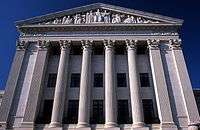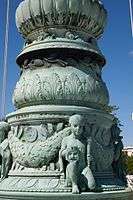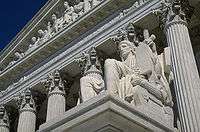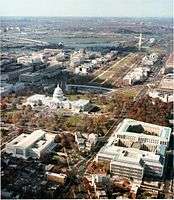United States Supreme Court Building
|
Supreme Court Building | |
|
Façade of the Supreme Court Building | |
| Location |
1 First Street, Northeast |
|---|---|
| Coordinates | 38°53′25.8″N 77°0′16.2″W / 38.890500°N 77.004500°WCoordinates: 38°53′25.8″N 77°0′16.2″W / 38.890500°N 77.004500°W |
| Built | 1935 |
| Architect | Cass Gilbert, Cass Gilbert Jr. |
| NRHP Reference # | 87001294[1] |
| Designated NHL | May 4, 1987[1] |
| This article is part of the series on the |
| United States Supreme Court |
|---|
 |
| The Court |
| Current membership |
| All members |
|
| Court functionaries |
|
The Supreme Court Building is the seat of the Supreme Court of the United States and the Judicial Branch thereof. Completed in 1935, it is situated in Washington, D.C. at 1 First Street, NE, on the block immediately east of the United States Capitol. The building is under the jurisdiction of the Architect of the Capitol. On May 4, 1987, the Supreme Court Building was designated a National Historic Landmark.[1][2] It is one of a handful of National Historic Landmarks which are not listed on the National Register of Historic Places.[3]
History
Prior to the establishment of the Federal City, the United States government resided briefly in New York City. As such, the Supreme Court met there during this time in the Merchants Exchange Building. When the capital moved to Philadelphia, Pennsylvania, the Court moved with it and began meeting in Independence Hall, before settling in Old City Hall at 5th and Chestnut Streets from 1791 until 1800.[4]
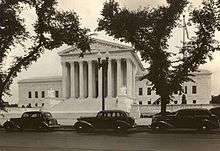

After the federal government moved to Washington, D.C., the court had no permanent meeting location until 1810. When the architect Benjamin Henry Latrobe built the second U.S. Senate chamber directly on top of the first US Senate chamber, the Supreme Court took up residence in what is now referred to as the Old Supreme Court Chamber from 1810 through 1860.[5] It remained in the Capitol until 1935, with the exception of a period from 1812 to 1819, during which the Court was absent from Washington because of the British invasion and the destruction of the Capitol during the War of 1812.[4]
In 1810, the Supreme Court first occupied the Old Supreme Court Chamber in the Capitol.[4] As the Senate expanded, it progressively outgrew its quarters. In 1860, the Supreme Court moved to the Old Senate Chamber (as it is now known) where it remained until its move to the current Supreme Court building.
In 1929, Chief Justice William Howard Taft argued successfully for the Court to have its own headquarters to distance itself from Congress as an independent branch of government, but he did not live to see it built. The court was finally designed by Cass Gilbert, who created many other structures in the United States.[6]
Temple of Justice
The Supreme Court Building is located at 1 First Street, NE (former site of the Old Brick Capitol, across the street from the United States Capitol) and was designed by architect Cass Gilbert (as Gilbert's last major project; he died before it was completed). It rises four stories (92 ft (28 m)) above ground. The cornerstone was laid on October 13, 1932, and construction completed in 1935, having cost $94,000 under the $9.74 million budget authorized by Congress. "The building was designed on a scale in keeping with the importance and dignity of the Court and the Judiciary as a coequal, independent branch of the United States Government, and as a symbol of 'the national ideal of justice in the highest sphere of activity.'"[4]
The Supreme Court Building is built in the Neoclassical style. The public façade is made of marble quarried from Vermont, and that of the non-public-facing courtyards, Georgia marble. Most of the interior spaces are lined with Alabama marble, except for the Courtroom itself, which is lined with Spanish ivory vein marble.[7] For the Courtroom's 24 columns, "Gilbert felt that only the ivory buff and golden marble from the Montarrenti quarries near Siena, Italy" would suffice. To this end, in May 1933, he petitioned the Italian Premier, Benito Mussolini, "to ask his assistance in guaranteeing that the Siena quarries sent nothing inferior to the official sample marble."
Not all the justices were thrilled by the new arrangements, the courtroom in particular. Harlan Fiske Stone complained it was "almost bombastically pretentious...Wholly inappropriate for a quiet group of old boys such as the Supreme Court." Another justice observed that he felt the court would be "nine black beetles in the Temple of Karnak," while still another complained that such pomp and ceremony suggested the justices ought to enter the courtroom riding on elephants. The New Yorker columnist Howard Brubaker noted at the time of its opening that it had "fine big windows to throw the New Deal out of."[8]
The west façade of the building (essentially, the "front" of the court, being the side which faces the Capitol) bears the motto "Equal Justice Under Law," while the east façade bears the motto "Justice, the Guardian of Liberty." On November 28, 2005, a basketball-sized chunk of marble weighing approximately 172 lb (78 kg) fell four stories from the west façade onto the steps of the Court; it had previously been part of the parapet above the word "under" in the "equal justice under law" engraving immediately above the figure of a Roman centurion carrying fasces. After the incident, planning was initiated to repair the west façade which includes cleaning, removal of debris and restoration. In 2012 scaffolding encased the west façade printed with a full-size photograph of the façade. The project was completed in 2013.[9]
The Supreme Court Building's facilities include:
- In the basement: maintenance facilities, garage, on-site mailroom.
- On the first (or ground) floor: Public information office, the clerk's office, the publications unit, exhibit halls, cafeteria, gift shop and administrative offices.
- On the second floor: the Great Hall, the courtroom, the conference room, and all of the justices' chambers except Justice Sotomayor (she swapped with Justice Ginsburg for a roomier office on the third floor).
- On the third floor: The office of Justice Sotomayor, the office of the Reporter of Decisions, the legal office, and the offices of the law clerks. Also, the justices' dining and reading rooms are on this floor.
- On the fourth floor: The court library
- On the fifth floor: The Supreme Court gym, including a basketball court (appropriately named the "Highest Court in the Land")[10]
In addition, the Supreme Court Building maintains its own police force, the Supreme Court Police. Separate from the Capitol Police, the force was created in 1935 to look after the building and its personnel.
Sculptural program
Cass Gilbert's design for the building and its environs included an ambitious Beaux-Arts-styled sculptural program that included a large number and variety of both real and allegorical figures.
- Supreme Court flagpole bases, and bronze doors in the east and west façades by John Donnelly.
- East pediment: Justice, the Guardian of Liberty by Hermon Atkins MacNeil
- West pediment: Equal Justice Under the Law by Robert Ingersoll Aitken. This work includes a portrait of Cass Gilbert, third from the left in the pediment. It also contains a self-portrait of Robert Ingersoll Aitken third from the right.
- Seated figures: The Authority of Law (south side) and The Contemplation of Justice (north side) by James Earle Fraser
- Great Hall: Busts of each of the Chief Justices of the United States in alcoves on either side of the Hall. These marble works are periodically appropriated by the Congress. The most recent addition was Chief Justice Rehnquist's bust in December 2009 to the far end of the north side of the Hall, just to the left of the Courtroom doors.
- Courtroom friezes: The South Wall Frieze includes figures of lawgivers from the ancient world and includes Menes, Hammurabi, Moses, Solomon, Lycurgus, Solon, Draco, Confucius, and Augustus. The North Wall Frieze shows lawgivers from the Middle Ages on and includes representations of Justinian, Muhammad, Charlemagne, John, King of England, Louis IX of France, Hugo Grotius, Sir William Blackstone, John Marshall, and Napoleon. The Moses frieze depicts him holding the Ten Commandments, although only commandments six through ten, usually considered the more secular commands, are visible. In 1997, the Council on American-Islamic Relations (CAIR) asked for the image of Muhammad to be removed from the marble frieze of the façade. While appreciating that Muhammad was included in the court's pantheon of 18 prominent lawgivers of history, CAIR noted that Islam discourages depictions of Muhammad in any artistic representation. CAIR also objected that Muhammad was shown with a sword, which they thought reinforced long-held stereotypes of Muslims as intolerant conquerors. Chief Justice William Rehnquist rejected the request to sandblast Muhammad, saying the artwork "was intended only to recognize him, among many other lawgivers, as an important figure in the history of law; it is not intended as a form of idol worship". The court later added a footnote to tourist materials, calling it "a well-intentioned attempt by the sculptor to honor Muhammad".[11]
|
Public access to the building
On May 3, 2010, citing security concerns and as part of the building's modernization project, the Supreme Court announced that the public (including parties to the cases being argued, the attorneys who represent them, and visitors to Oral arguments or the building) would no longer be allowed to enter the building through the main door on top of the steps on the west side.[12] Visitors must now enter through ground-level doors located at the plaza, leading to a reinforced area for security screening. The main doors at the top of the steps may still be used to exit the building.[12] Justice Breyer released a statement, joined by Justice Ginsburg, expressing his opinion that although he recognizes the security concerns that led to the decision, he does not believe on balance that the closure is justified.[13] Calling the decision "dispiriting", he said he was not aware of any Supreme Court in the world that had closed its main entrance to the public.[13]
All visitors to the Court must pass through metal-detectors and have their belongings X-rayed. Cameras are permitted in the building, but no recording devices of any kind, audio, or visual, are ever permitted in the Courtroom. When the Court is not in session, visitors can walk through the Great Hall and public areas on the ground floor, including the cafeteria and a small movie theater presenting a documentary of the Court, and guided lectures are periodically given in the Courtroom, which is not otherwise accessible. The schedule for the lectures can be confirmed on the Court's website the day before a visit. The line for these tours forms in a designated area to the side of the Courtroom doors.[14]
When the Court is in session, the Great Hall is not open to the public, except for those attending Court. The arguments are typically held in two-week cycles of a 10 A.M. and 11 A.M. argument on Mondays, Tuesdays, and Wednesdays.[15] Depending on the significance of the case and the time of year (winter arguments are less popular), visitors should arrive at the Court anywhere from two hours in advance to, in extremely controversial cases, the night before. At some point in the morning, which is not predetermined, the Supreme Court Police Officers distribute numbered tickets. These serve as place-holders only and not a guarantee of admission. Visitors who have tickets may leave the area and return at the appointed time to line up in numerical order, usually one hour before the argument. At this time, there usually are several hundred persons waiting outside the Court, most of whom are not able to observe either argument.[16] While the Courtroom does have seating for some 250 public visitors, in practice there are almost always large groups of students or officials that reduce that number, and visitors who are admitted to observe the first argument generally stay for the second argument, making the total seats available for the second argument generally very small. Just before the first argument, the officers divide the crowd into two lines: one is for those waiting with tickets to observe the entire argument, while the other is to observe a five-minute span of the argument while standing in the back of the Courtroom. Both lines remain in place during the first argument. Visitors must stand when the Justices enter and leave, and remain absolutely silent. Drowsy, noisy, or otherwise disruptive visitors are promptly removed by plainclothes officers. Parents are strongly discouraged from bringing small children.[14]
On Sunday, January 13, 2002, a wild fox wandered into the building. Although spotted by a police officer and observed on video cameras, the fox eluded capture for more than a day.[17]
See also
References
- 1 2 3 "Supreme Court Building". National Historic Landmarks Program. National Park Service. Retrieved 2009-06-18.
- ↑ "Photos, exterior and interior, of the U.S. Supreme Court Building" (PDF). Note that photos but not National Historic Landmark nomination text, if any exists, are available on-line. National Park Service.
- ↑ The Supreme Court Building and just a few other buildings are not listed on the National Register of Historic Places, per enabling legislation for the National Register, probably for separation of powers reasons.
- 1 2 3 4 "Overview of the Supreme Court Building". United States Supreme Court. Retrieved 2010-03-19.
- ↑ Rehnquist, William H. (2001) [1987]. The Supreme Court (2nd ed.). Vintage Books (Random House, Inc). p. 24. ISBN 0-375-70861-8.
- ↑ "Study for Woolworth Building, New York". World Digital Library. 1910-12-10. Retrieved 2013-07-25.
- ↑ "History of the Court: Homes of the Court". supremecourthistory.org. Retrieved 2014-11-15.
- ↑ Tomlins, Christopher (2005). The United States Supreme Court: The Pursuit of Justice (1st ed.). Houghton Mifflin. ISBN 0-618-32969-2.
- ↑ "Supreme Court West Façade Restoration". Architect of the Capitol. June 5, 2013. Retrieved June 19, 2013.
- ↑ Liptak, Adam; Purdum, Todd S. (2005-07-31). "As Clerk for Rehnquist, Nominee Stood Out for Conservative Rigor". The New York Times. Retrieved 2010-05-27.
- ↑ Mauro, Tony (2005-03-02). "The Supreme Court's Own Commandments". law.com. Retrieved 2008-11-02.
- 1 2 "Press release on new visitor entrance" (WORD). 2010-05-03. Retrieved 2010-05-06.
- 1 2 "Statement Concerning the Supreme Court's Front Entrance; memorandum by Justice Breyer" (PDF). 2010-05-03. Retrieved 2010-05-06.
- 1 2 "Plan Your Visit – Supreme Court of the United States". Supremecourt.gov. Retrieved 2012-08-02.
- ↑ "Visitor's Guide to Oral Argument". Supremecourt.gov. Retrieved 2012-08-02.
- ↑ "The Court Building – Supreme Court of the United States". Supremecourt.gov. 1932-10-13. Retrieved 2012-08-02.
- ↑ Biskupic, Joan (2002-01-15). "Sly intruder infiltrates Supreme Court". USA Today. pp. A3. Retrieved 2008-11-02.
External links
 Media related to United States Supreme Court Building at Wikimedia Commons
Media related to United States Supreme Court Building at Wikimedia Commons Geographic data related to United States Supreme Court Building at OpenStreetMap
Geographic data related to United States Supreme Court Building at OpenStreetMap- Supreme Court of the United States
- Virtual tour
- Outdoor sculpture at the Supreme Court Building
- Supreme Court Building
- "Architectural Information Sheets". Supreme Court of the United States. Retrieved 2010-03-19.
- A Permanent Home—Supreme Court Historical Society
- Supreme Court Visitors Guide
- Supreme Court Visitors Guide for Oral Arguments
- National Register of Historic Places listing for the United States Supreme Court Building
- C-SPAN's Building the Court

